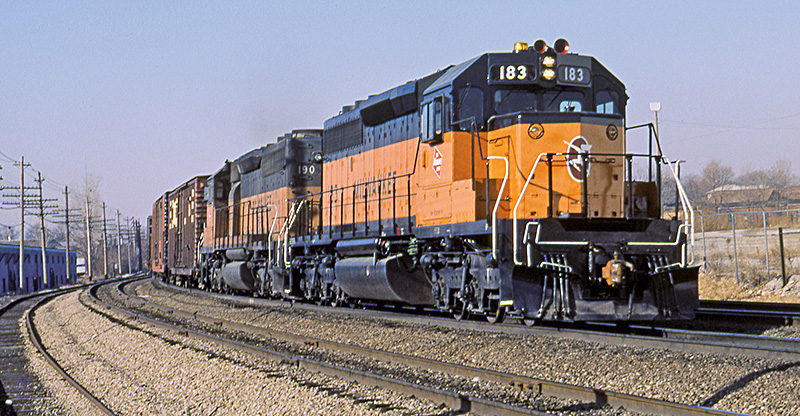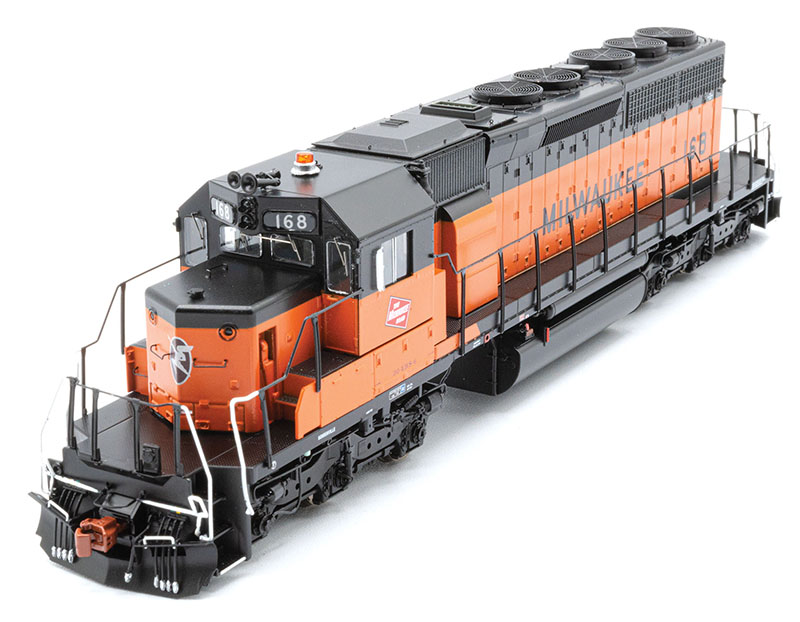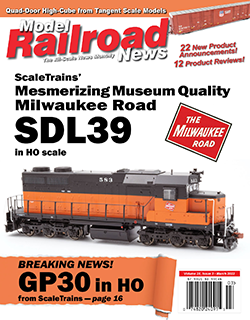
By Ryan Crawford
In 2016, ScaleTrains embarked on an ambitious project to create a “definitive” Electro-Motive Division (EMD) HO-scale SD40-2. This was no doubt a wise choice for the Tennessee-based manufacturer as the prototype SD40-2s were super popular and were built with an almost unlimited number of phases and details. I think it’s safe to say, after seven separate runs of these near museum quality offerings that ScaleTrains continues to wow the hobby industry. Now, in its seventh run, ScaleTrains is offering Rivet Counter HO-scale SD40-2s decorated for Santa Fe (reviewed in MRN’s February 2022 edition), Milwaukee Road Hiawatha repaints, Norfolk Southern (Admiral cab), Nacionales de Mexico (watch for the review in May 2022’s MRN), and CSX’s YN3 Boxcar scheme. These offerings are available as Digital Command Control (DCC) and sound equipped or standard DC (with DCC-ready electronics). This review will focus on ScaleTrains’ Rivet Counter HO-scale SD40-2 decorated as The Milwaukee Road 168 in the repainted Hiawatha scheme as the unit appeared in the mid-1980s. The review sample model is equipped with ESU’s LokSound V5 sound electronics, and is dual mode, allowing it to be used on a DC or DCC layout. In this latest run of Rivet Counter SD40-2s, the company is also offering three additional Milwaukee Road SD40-2s in the repainted Hiawatha scheme numbered 142, 149, and 159.

ABOVE: Looking sharp, MILW 183 was eastbound leaving Kansas City on February 8, 1984. The review model includes all the details, such as the plow, white appointments to the railings, grab irons, and coupler lift bars. The one interesting thing about SD40-2 183 is that the horn bells are painted red on the inside. — Kevin EuDaly photo
The Milwaukee Road SD40-2s
Chicago, Milwaukee, St. Paul & Pacific, more commonly known as The Milwaukee Road, was one of several of the nation’s Class 1 railroads that chose EMD’s new and improved SD40-2 in the 1970s. The Milwaukee Road purchased 90 SD40-2s from July 1972 through July 1974, in four separate groups. All Milwaukee SD40-2s were fitted with an 81-inch nose, standard dynamic brakes, a ratchet-style handbrake on the fireman’s side of the short hood, an electronic bell on the cab, and a Leslie three-chime horn. Milwaukee’s SD40-2s are considered early-phase units with the riveted cab side around the window, the early bolt-on two-slot battery box covers, and the zig-zag sheet steel separation behind the cab. Among the interesting options specified by Milwaukee for its 90-unit order were snowplows front and rear and a 3,200-gallon fuel tank. The small plow on the rear, also referred to as a weed-cutter plow, and the short fuel tank made Milwaukee’s SD40-2s very distinctive. They were all painted in the same color scheme when they were new, with the famous black and orange car body and black underframe. When they were built by EMD, the road number was placed on the forward section of the dynamic brake blister. The one major difference in the original paint scheme worn by the SD40-2s was that the first group (3000–3040) lacked The Milwaukee Road block lettering; this was added at a later date by the railroad. Over time, the railroad made some equipment changes to its SD40-2 fleet, including the removal of the electronic bell from the cab roof and the addition of a Prime beacon to the center of the cab roof. A new bell and bracket were added to the side of the car body behind the fireman. Model Railroad News’ review model is MILW SD40-2 168, showcasing Milwaukee’s Hiawatha repaint scheme. The prototype SD40-2 168 was originally numbered 3038 and was delivered to the railroad and placed in service on August 25, 1972.
When we dive into the roster details of Milwaukee’s SD40-2s, it gets a little complicated. The first order, for 41 units, carried road numbers 3000–3040. The second order, for 11 units, carried road numbers 171–181 (this order was delivered from EMD with the black “Milwaukee Road” block lettering). The third order, for 10 units, carried road numbers 21–30 and the fourth and final order was numbered 182–209 (this final order was delivered from the factory with a Prime beacon atop the cab, and the railroad eventually installed a Prime beacon on all its SD40-2s). The madness doesn’t end there, as the first group (3000–3040) was renumbered 130–170 in 1973 and 1974. For those keeping score, MILW SD40-2s 21–30 featured Locotrol equipment, with 21–25 as the master units, and 26–30 being the slave units. The Milwaukee Road SD40-2s were initially assigned to the company’s transcontinental trains: XL Special and Thunderhawk. Throughout the years, these venerable EMD workhorses saw systemwide service for The Milwaukee Road and later Soo Line, which bought the assets of the mighty Milwaukee Road in February 1985. The prototype Milwaukee 168 was slated to become Soo Line 6342; however, it was not renumbered. It then went to Morrison-Knudsen where it was rebuilt, becoming Ferrocarriles Nacionales de Mexico 13020. The four N de M road numbers offered in this latest Rivet Counter SD40-2 release include ex-Milwaukee 168 which became N de M’s 13020. The Rivet Counter N de M, ex-MILW SD40-2s feature a larger 4,000-gallon fuel tank, which replaced the original 3,200-gallon tank after they were rebuilt at Morrison-Knudsen.
ScaleTrains’ Hiawatha SD40-2
ScaleTrains’ HO-scale Rivet Counter Milwaukee SD40-2 168 bristles with details and includes all the equipment found on the prototype Hiawatha repaints. Noteworthy detail changes include: a standard bell located on the fireman’s side of the long hood behind the cab, and the road number (deleted from the dynamic blister) relocated to the rear of the long hood in black, block-style lettering. Also, a common trait to all the MILW SD40-2s was the addition of a Prime beacon and a whip antenna on the cab roof.
ScaleTrains’ HO-scale Rivet Counter SD40-2s are not foreign to me, as I previously reviewed the manufacturer’s HO-scale Rivet Counter Burlington Northern SD40-2 in the November 2017 issue of MRN. The consistency is impressive as ScaleTrains makes every attempt to decorate these Rivet Counter EMDs correctly and thoroughly. As I examined the review model, I appreciated the nicely rendered one-inch cut stencil lettering in white, within the black band under the radiator compartment. Just as on the prototype Hiawatha repaints, the model includes “Fire Extinguisher Inside,” “Engine Water Fill Inside,” and “Engine Start Switch Inside” lettering Proper demarcations are also located on the cab side with a red canted “The Milwaukee Road” decal and the railroad’s locomotive designation of “30-ERS-6” … this refers to 30=3,000hp, ERS=EMD Road Switcher, 6=six axles. Even the tiniest printing is legible, such as the “LG-49” label in 1-inch black letters on the air access doors and the white “Bensenville” maintenance stencil on the frame. After scouring books, magazines, and online photo sources, the meaning of the “LG-49” label still eluded me. I sent an email to Michael Hopkin of ScaleTrains to gather some insight as to what this meant. His quick reply was that it was a paint code that was applied to this particular Milwaukee repaint. This must have been hit-and-miss as I only found a handful of repainted Milwaukee SD40-2s with a paint code on the air equipment door under the cab. The block Milwaukee lettering on the car body was tack sharp, as was the Hiawatha herald on the nose. It is easy to see that ScaleTrains pays attention to the minutiae when researching the decal and lettering placement for these top-notch Rivet Counter models.
One noticeable difference between the original Milwaukee paint scheme and the Hiawatha repaint scheme is the neat, yet subtle, zig-zag paint pattern behind the cab. For whatever reason, the Hiawatha scheme required the top separation stripe to be moved up on the car body by a few inches. When comparing the two schemes, the Hiawatha scheme has the top separation line just barely covering the water sight glass on the engineer’s side of the long hood. On the fireman’s side the lower portion of the zig-zag pattern follows the raised traction motor blower duct. This was an interesting paint detail that definitely creates an optical illusion when viewed from the side. ScaleTrains has masterfully recreated these Hiawatha repaint nuances on this Rivet Counter release.
Model Railroad News’ review sample also includes finely molded 48-inch fans with etched-metal blades on top of the long hood. These are correct for an early SD40-2 with eight-blade fans for the radiators and a pair of nine-blade fans atop the dynamic brake blister. The round etched screens are also present which really give the model some great detail relief. The grab irons, railings, and wire eyebolts were all applied in the proper places and in the correct color. It’s interesting to note that the engineer’s side of the cab includes a two-pane all-weather window, as MILW added this after delivery. On prototype SD40-2 168, the all-weather window frame was cleaned up and repainted. ScaleTrains simply painted the window frame silver to make it look like cleaned up and repainted steel, a neat trick that definitely looks the part. The engineer’s side of the cab also has the cab vent placed nearly in the middle of the cab side under the window.
ScaleTrains’ Rivet Counter HO-scale MILW SD40-2 168 also has a ton of details down low, such as the road-specified 3,200-gallon fuel tank, six-axle HTC flexi-coil trucks (the standard truck for EMD’s SD40-2), fuel fillers on each side of the fuel tank, and a fully detailed underbody with truck piping and sander lines. With a large gap between the rear of the front truck and the fuel tank, there’s no mistaking the identity of this EMD SD40-2. One of the many impressive details of the Rivet Counter SD40-2s is the clever chain and tensioner rigging on the fireman’s side of the front truck. It looks to be attached; however, a portion of the tensioner actually pivots with the truck which is a very crafty detail that looks spectacular. The pilots and solid end railings are dead accurate for Milwaukee SD40-2s as they have no drop steps. The pilots also include the early 45-degree corner lifting/rerailing holes. Common to all Rivet Counter SD40-2s is a fully detailed pilot with MU and actuating cables draped over the front plow and the nicely-rendered coupler cut lever highlighted in white. Of course, the rear pilot has the Milwaukee-specific small plow.
As I examined the review model, I did not find any glue oozing or bent handrails or grab irons. The window glass and number board inserts were solid and straight. The forward radiator fan had a bent screen that I carefully fixed with a hobby knife by lifting it back into position.
On the Test Track
Model Railroad News’ review sample Milwaukee 168 was tested using my home layout, which utilizes a Digitrax DCC system. When I placed the model on the main line and turned the power on, the number boards lit up. I dialed up address 03 on my controller and then pressed function button F8 to activate the ESU decoder sounds. Once F8 was pressed, the EMD 645 sound file roared to life through the dual sugar-cube speakers located inside the rear of the shell. The steady whining of the turbocharger was the predominant sound while the unit was idling. Like any ESU-equipped ScaleTrains locomotive, the user must wait until the start-up sequence is completed before the unit will move. At this time, I checked that the locomotive moved in forward and reverse. Then I reprogrammed the decoder address from 03 to the model’s road number of 168. I then checked the headlights by pressing function button F0. The headlights from the factory are programmed to light up in the direction of travel, which they did. The LED headlights were just about right in brightness, which is another detail that ScaleTrains has really dialed in on their locomotive releases. Now the fun begins! The Prime beacon was activated by pressing function button F7, and it was awesome as the mini-LED faded in and out to mimic the four bulbs flashing in a sequential pattern. Gotta love those beacons!
I warmed up the review model for about 30 minutes on the layout and then testing commenced. I pulled a coal train with it, switched some cars, and tried out a few of the neat ESU functions such as the “drive hold” feature by activating F9 on my controller. The “drive hold” allows the user to ramp up the motor RPM sounds while moving at a snail’s pace. This is incredibly realistic when moving a long cut of cars or negotiating a tough grade at low speed. I also initiated the dynamic brake sounds by pressing F4 on my controller. I really enjoy enabling the ESU sound for the dynamics as the decoder’s sound file is programmed in such a way that it includes the realistic lag time for this particular sound feature. The real-time audio of the prime mover idling down and the whirring of the dynamic brakes make operations very realistic. In fact, I have had to practice using the dynamics to achieve a highly prototypical use of the feature. This HO-scale SD40-2 negotiated number 4 and number 6 switches gracefully and didn’t stutter, stop, or have a sound interruption during the testing. ScaleTrains recommends no less than a 22-inch radius curve for its Rivet Counter SD40-2. So, I maxed it out on my only 22-inch radius curve and it didn’t miss a beat. ScaleTrains includes plastic sander lines on the shell of the model, which prototypically hang down fore and aft of the trucks. The sander lines are made of plastic and make a clicking noise as the locomotive negotiates curves. In the past, I have remedied this by disconnecting the sander lines from the shell and attaching them to the truck ends. I also shorten the lines to reduce any chance of the sander lines interfering with the truck’s rotation. The model weighs 18.8 ounces, so it has some serious lugging ability. I checked the wheels with my Kadee gauge and found them to be correct, and the coupler height on both ends was perfect. The provided ScaleTrains scale-head metal knuckle couplers worked satisfactorily while testing the review model.
Closing
It’s hard to believe that ScaleTrains has been around for more than six years and has produced so many exciting Rivet Counter SD40-2s! The company made a wise choice to continue releasing a finely detailed and well running EMD SD40-2 which allows for an almost limitless number of details, phases, and road names. By releasing an SD40-2 in Milwaukee’s Hiawatha scheme, it garners additional interest for those modelers searching out 1980s prototypes. The Milwaukee Road has always been a very popular road name for modelers of all scales, and without a doubt, this HO-scale Milwaukee Road Hiawatha scheme Rivet Counter SD40-2 will be admired by those fans of “America’s Resourceful Railroad!”
ScaleTrains.com
844-987-2468
ScaleTrains.com



 See more pictures and enjoy the complete review in March 2022’s Model Railroad News!
See more pictures and enjoy the complete review in March 2022’s Model Railroad News!